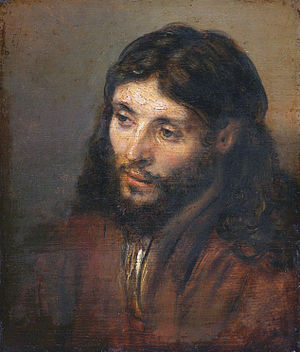A Christ after life

|
| A Christ after life |
|---|
| Rembrandt van Rijn , 1648 |
| Oil on oak |
| 25 × 21.5 cm |
| Gemäldegalerie (Berlin) |
The picture A Christ after Life , also known as the Christ Head, was painted by Rembrandt van Rijn around 1648 . It is 25 centimeters high and 21.5 centimeters wide and applied to oak wood . Rembrandt depicted Jesus based on a Jewish model. This painting thus marks a turning point in Rembrandt's view of Judaism and the Jews . It is now in the Berlin Gemäldegalerie .
Image description
The picture shows a Jewish model representing the Son of God in three-quarter view. The head is slightly inclined and turned to the left and, together with the gaze averted from the viewer, conveys devotion and lost thought. The paint is applied thinly in the dark areas of the painting; instead, it is impasto in the light areas of the face . This promotes the impression of the immediacy of the depicted, which underlines the function of the picture as a study. But despite the work on the model, the picture with the dark, long hair, the level-headed look and the regular facial features still shows elements of the traditionally widespread image of Christ.
The painting surface is an oak board. It comes from the same tribe as that of Rembrandt's self-portrait in the Museum of Fine Arts in Leipzig , which dendrochronological studies have shown. According to this, the picture could not have been created until 1645 and 1648 at the latest.
background
In the late 1940s and early 1950s, Rembrandt first studied the physiognomy of Jewish models. The Jewish population of Amsterdam had grown as a result of the exile from the Iberian Peninsula after the defeat of the Moors , who were tolerant of religious issues . The Jews did not have to wear identification marks and were only subject to a few restrictions. They integrated into the economy and wore Dutch clothes. Only the Spanish or Portuguese language was a typical distinguishing feature for them. Up until then, Rembrandt only used physical features assigned to Jews when depicting them in negative contexts and reinforced these traditionally depicted facial features. For example, he applied it to depicting the high priests who were held responsible for the death of Jesus. With the increasing knowledge of the Jews in his neighborhood, Rembrandt's relationship with them changed so that he now also painted Christ according to a Jewish model. This study on the model was also reflected in later history paintings and engravings, when Rembrandt also made the facial features of the followers of Jesus more realistic.
Rembrandt made several studies on portraits of Jesus. For example, two heads of Jesus attributed to him can be found in his possession for the year 1656. The Berlin picture also shows great similarities in brushwork and size with the painting Portrait Study of a Young Jew , also made around 1648 , which is also in the possession of the Gemäldegalerie. The authorship of the work is recognized. However, it was at times questioned by Jan Kelch , who was the director of the picture gallery, for example . After further research, however, he was convinced that it was a painting made by Rembrandt himself.
Provenance
The painting A Christ after Life came to Prussia as a dowry from Luise Henriette von Oranien , who was married to Friedrich Wilhelm von Brandenburg on December 7, 1646 . After the death of her parents, several paintings, including those by Rembrandt, Peter Paul Rubens and Titian, came into his possession. From 1830 it was shown in the picture gallery opened in the Altes Museum . During the Second World War , the painting A Christ after Life was brought to safety in the Kaiserroda salt mine in Thuringia, along with the other works by Rembrandt in the Gemäldegalerie . There it was discovered by American soldiers at the end of the war and subsequently brought to the United States . There it toured with the exhibition of 202 through various cities in the USA until it was returned to the Collecting Point in Wiesbaden . In 1955 it was returned from there to Berlin-Dahlem . Since 1998 the picture has been shown in the new picture gallery at the Kulturforum .
Individual evidence
- ↑ a b c Kristin Bahre et al. (Ed.): Rembrandt. Genius in search. DuMont Literature and Art, Cologne 2006. Page 356.
- ↑ a b Christian Tümpel: Rembrandt in self-testimonies and image documents. Rowohlt, Reinbek 1977. page 75.
- ↑ Christian Tümpel: Rembrandt in self-testimonies and image documents. Rowohlt, Reinbek 1977. Pages 70 and 71.
- ↑ a b Ingeborg Ruthe: Collective pictures at court in the Berliner Zeitung of August 3, 2008, accessed on December 2, 2008
literature
- Christian Tümpel: Rembrandt . Rowohlt Taschenbuch Verlag, Reinbek 2006, ISBN 3-499-50691-2 .
- Kristin Bahre et al. (Ed.): Rembrandt. Genius in search . DuMont Literature and Art, Cologne 2006, ISBN 3-8321-7694-2